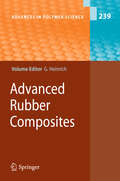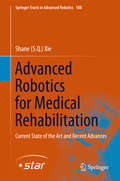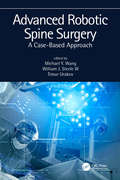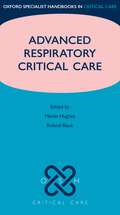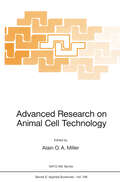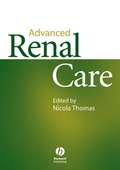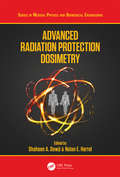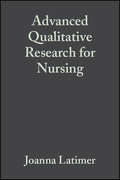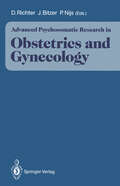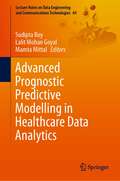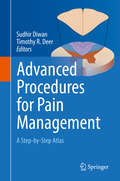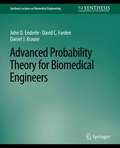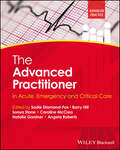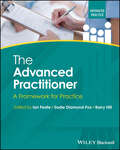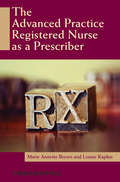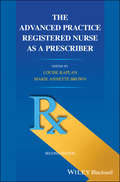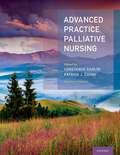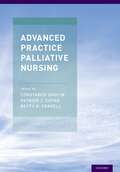- Table View
- List View
Advanced Rubber Composites (Advances in Polymer Science #239)
by Gert HeinrichMorphology–Property Relationship in Rubber-Based Nanocomposites: Some Recent Developments, by A. K. Bhowmick, M. Bhattacharya, S. Mitra, K. Dinesh Kumar, P. K. Maji, A. Choudhury, J. J. George and G. C. Basak; * Rubber–Clay Nanocomposites: Some Recent Results, by Amit Das, De-Yi Wang, Klaus Werner Stöckelhuber, René Jurk, Juliane Fritzsche, Manfred Klüppel and Gert Heinrich; * Surface Modification of Fillers and Curatives by Plasma Polymerization for Enhanced Performance of Single Rubbers and Dissimilar Rubber/Rubber Blends, by J. W. M. Noordermeer, R. N. Datta, W. K. Dierkes, R. Guo, T. Mathew, A. G. Talma, M. Tiwari and W. van Ooij; * Recent Developments on Thermoplastic Elastomers by Dynamic Vulcanization, by R. Rajesh Babu and Kinsuk Naskar; * PTFE-Based Rubber Composites for Tribological Applications, by M. S. Khan and G. Heinrich
Advanced Robotics for Medical Rehabilitation: Current State of the Art and Recent Advances (Springer Tracts in Advanced Robotics #108)
by Shane (S.Q.) XieFocussing on the key technologies in developing robots for a wide range of medical rehabilitation activities – which will include robotics basics, modelling and control, biomechanics modelling, rehabilitation strategies, robot assistance, clinical setup/implementation as well as neural and muscular interfaces for rehabilitation robot control – this book is split into two parts; a review of the current state of the art, and recent advances in robotics for medical rehabilitation. Both parts will include five sections for the five key areas in rehabilitation robotics: (i) the upper limb; (ii) lower limb for gait rehabilitation (iii) hand, finger and wrist; (iv) ankle for strains and sprains; and (v) the use of EEG and EMG to create interfaces between the neurological and muscular functions of the patients and the rehabilitation robots.Each chapter provides a description of the design of the device, the control system used, and the implementation and testing to show how it fulfils the needs of that specific area of rehabilitation. The book will detail new devices, some of which have never been published before in any journal or conference.
Advanced Robotic Spine Surgery: A case-based approach
by Michael Wang William J. Steele III Timur UrakovRobotic spine surgery is one of the fastest growing segments of the spine surgery market. Surgeons specialising in spine surgery are highly motivated to learn and improve their understanding of the indications,application,and future clinical scope of using new technological platforms. Spinal surgeons face time pressures but are hungry for new ways to effectively treat patients. This book presents information in the case study format. By using examples of surgical cases of an advanced nature (e.g. spinal deformity, minimally invasive surgery, combinatorial technology using the robot) this will differ from other texts. Each case study is written by a well-respected expert in the field and represents that surgeon’s most monumental case. Each case contains a concise patient history with indications, contraindications and insights to help the reader assimilate expert knowledge. The case studies examine both the unique and technical aspects of robotic planning and surgical execution, and include seminal bullet point sections: Key take away points; Tips and pearls to avoid pitfalls; and "how I could have done this better.” This new text provides valuable and practical knowledge for spine surgeons and others involved in robotic surgery.
Advanced Robotic Spine Surgery: A case-based approach
by Michael Y. Wang Steele III, William J. Timur UrakovRobotic spine surgery is one of the fastest growing segments of the spine surgery market. Surgeons specialising in spine surgery are highly motivated to learn and improve their understanding of the indications,application,and future clinical scope of using new technological platforms. Spinal surgeons face time pressures but are hungry for new ways to effectively treat patients. This book presents information in the case study format. By using examples of surgical cases of an advanced nature (e.g. spinal deformity, minimally invasive surgery, combinatorial technology using the robot) this will differ from other texts. Each case study is written by a well-respected expert in the field and represents that surgeon’s most monumental case. Each case contains a concise patient history with indications, contraindications and insights to help the reader assimilate expert knowledge. The case studies examine both the unique and technical aspects of robotic planning and surgical execution, and include seminal bullet point sections: Key take away points; Tips and pearls to avoid pitfalls; and "how I could have done this better.” This new text provides valuable and practical knowledge for spine surgeons and others involved in robotic surgery.
Advanced Respiratory Critical Care (Oxford Specialist Handbooks in Critical Care)
by Martin Hughes Roland BlackRespiratory disease is the most common reason for admission to intensive care, and advanced respiratory support is one of the most frequently used interventions in critically ill patients. A clear understanding of respiratory disease is the cornerstone of high quality intensive care. Although a plethora of literature is available, both in print and online, finding the necessary relevant information can be difficult and time consuming. This handbook provides comprehensive clinical detail in an easily readable format. It is written by practising clinicians and has both in-depth theoretical discussion and practical management advice. The book is divided into sections: Section 1 deals with the approach to the patient with respiratory failure - including pathophysiology, investigation and diagnosis Sections 2 covers non invasive treatment modalities Sections 3 and 4 examine invasive ventilation in detail. Section 3 considers the principles of mechanical ventilation while section 4 deals with individual ventilator modes Section 5 discusses the management of the ventilated patient including sedation, monitoring, asynchrony, heart - lung interaction, hypercapnia and hypoxia, complications, weaning and extubation. It also has chapters on areas less frequently covered such as humidification, suction, tracheal tubes and principles of physiotherapy Section 6 is a comprehensive breakdown of each respiratory condition seen in ICU. This book is designed to bridge the gap between Intensive Care starter texts and all-encompassing reference textbooks. It is aimed at consultants and senior trainees in Intensive Care Medicine, senior ICU nursing staff, consultants in other specialties and allied healthcare professionals who have an interest in advanced respiratory critical care.
Advanced Research on Animal Cell Technology (NATO Science Series E: #156)
by Alain O. A. MillerProceedings of the NATO Advanced Research Workshop, Brussels, Belgium, September 21-24, 1987
Advanced Renal Care
by Nicola ThomasIndividuals with renal disease require continuing support and care throughout their lives from renal nurses and other members of the inter-professional renal team. Advanced Renal Care is for all those who work in nephrology, dialysis and transplantation as it addresses current challenges in caring for those with renal failure, and examines recent trends and likely future developments. The book also explores key issues in staff recruitment and development. It goes beyond the basic texts on renal care by discussing topical issues such as anaemia management, care of older people on dialysis, diabetes and renal failure, infection control and sexual dysfunction in renal disease.
Advanced Radiation Protection Dosimetry (Series in Medical Physics and Biomedical Engineering)
by Shaheen A. Dewji Nolan E. HertelAlthough many radiation protection scientists and engineers use dose coefficients, few know the origin of those dose coefficients. This is the first book in over 40 years to address the topic of radiation protection dosimetry in intimate detail. Advanced Radiation Protection Dosimetry covers all methods used in radiation protection dosimetry, including advanced external and internal radiation dosimetry concepts and regulatory applications. This book is an ideal reference for both scientists and practitioners in radiation protection and students in graduate health physics and medical physics courses. Features: A much-needed book filling a gap in the market in a rapidly expanding area Contains the history, evolution, and the most up-to-date computational dosimetry models Authored and edited by internationally recognized authorities and subject area specialists Interrogates both the origins and methodologies of dose coefficient calculation Incorporates the latest international guidance for radiation dosimetry and protection
Advanced Radiation Protection Dosimetry (Series in Medical Physics and Biomedical Engineering)
by Shaheen Dewji Nolan E. HertelAlthough many radiation protection scientists and engineers use dose coefficients, few know the origin of those dose coefficients. This is the first book in over 40 years to address the topic of radiation protection dosimetry in intimate detail. Advanced Radiation Protection Dosimetry covers all methods used in radiation protection dosimetry, including advanced external and internal radiation dosimetry concepts and regulatory applications. This book is an ideal reference for both scientists and practitioners in radiation protection and students in graduate health physics and medical physics courses. Features: A much-needed book filling a gap in the market in a rapidly expanding area Contains the history, evolution, and the most up-to-date computational dosimetry models Authored and edited by internationally recognized authorities and subject area specialists Interrogates both the origins and methodologies of dose coefficient calculation Incorporates the latest international guidance for radiation dosimetry and protection
Advanced Qualitative Research for Nursing
by Joanna LatimerThis collection presents up-to-the-minute qualitative research methodologies creatively developed by and within nursing. The book is written by authors at the forefront of their fields. It is aimed at enabling people to research critical issues for nursing practice and health care. Nurses face the imperative for practice grounded in research-based evidence. The book demonstrates how qualitative methodologies can produce rigorous and valid research. Drawing on empirical data each chapter introduces a particular contemporary approach; examines the literature in its field; discusses its relevance for nursing and health care; and explains what claims to knowledge can be made.
Advanced Psychosomatic Research in Obstetrics and Gynecology
by PietNijs JohannesBitzer DietmarRichterGynecologists cannot fulfill the commitments of their profession without being psychosomatically oriented. Nevertheless, this field needs methodology and scientific thinking just as does any other subspeciality in clinical medicine. Although practiced by all gyne cologists, creative work is needed in order to develop the various aspects properly and to establish postgraduate training on a firm and sound basis. For this purpuse the European Symposia have been planned by several European Researchers on Psychosomatic Obstetrics and Gynecology in order to stimulate and integrate clinical scientific data and therapeutic skills in the bio-psycho-social field of obstetrics and gynecology. The first European Symposium in Leuven 1985 concentrated on the psychosomatic aspects of infertility and high risk pregnancies. This second European Symposium in Bad Sackingen centered around disturbed body perception, disturbances of the menstrual cycle, climacteric syndrome, and senium. These topics were elaborated in main lectures and workshops held by outstanding researchers in this rapidly expanding field. The second European Symposium on Psychosomatic Obstetrics and Gynecology was organized by the German Society of Psycho somatic Obstetrics and Gynecology, supported by the University Hospital Freiburg/Br., the University Hospital Basel, and the Women's District Hospital in Bad Sackingen.
Advanced Prognostic Predictive Modelling in Healthcare Data Analytics (Lecture Notes on Data Engineering and Communications Technologies #64)
by Sudipta Roy Lalit Mohan Goyal Mamta MittalThis book discusses major technical advancements and research findings in the field of prognostic modelling in healthcare image and data analysis. The use of prognostic modelling as predictive models to solve complex problems of data mining and analysis in health care is the feature of this book. The book examines the recent technologies and studies that reached the practical level and becoming available in preclinical and clinical practices in computational intelligence. The main areas of interest covered in this book are highest quality, original work that contributes to the basic science of processing, analysing and utilizing all aspects of advanced computational prognostic modelling in healthcare image and data analysis.
Advanced Procedures for Pain Management: A Step-by-Step Atlas
by Sudhir Diwan Timothy R DeerEdited by Sudhir Diwan, a former Director of Pain Medicine fellowship program at Ivy League Weill Cornell Medical College, and Timothy R. Deer, an internationally renowned expert in neuromodulation and minimally invasive spinal procedures, this atlas covers advanced procedures that normal residency and fellowship programs may not cover. It consolidates information pain fellows usually amass by traveling throughout the country to various specialized weekend courses. Advanced Procedures for Interventional Pain Management: A Step-by-Step Atlas is for physicians that know the fundamentals of pain medicine and want to push their knowledge further. Through easy-to-digest bullet points, extensive diagrams, hundreds of figures, and expanded legends beneath each illustration, this compendium covers techniques such as fluoroscopic guidance and radiation safety, endoscopic transforaminal discectomy, endoscopic direct-percutaneous discectomy, transforaminal myelogram, percutaneous facet fusion, percutaneous sacroplasty, vertebral augmentations, percutaneous tumor ablation, percutaneous spinal fusion, minimally invasive spinal decompression (MILD), Interspinous Spacer Placement and advanced neuroaugmentation techniques like high frequency stimulation and DRG stimulation. This book also has a dedicated section on Regenerative Medicine with chapters on platelet rich plasma, stem cell therapy, and intradiscal regenerative therapy. Each chapter has a strict chapter format that includes the indications and contraindications for each procedure, a list of equipment and drugs, a step-by-step illustration-focused how-to, a list of possible post-procedural complications, and bullet-pointed clinical pearls and pitfalls. Within each chapter the authors will also cover the variations of each procedure due to different equipment. This book is ideal for pain medicine fellows, spine surgeons, and interventional pain physicians who want access to the best minds and specialized procedures in a single package.
Advanced Probability Theory for Biomedical Engineers (Synthesis Lectures on Biomedical Engineering)
by John Enderle David Farden Daniel KrauseThis is the third in a series of short books on probability theory and random processes for biomedical engineers. This book focuses on standard probability distributions commonly encountered in biomedical engineering. The exponential, Poisson and Gaussian distributions are introduced, as well as important approximations to the Bernoulli PMF and Gaussian CDF. Many important properties of jointly Gaussian random variables are presented. The primary subjects of the final chapter are methods for determining the probability distribution of a function of a random variable. We first evaluate the probability distribution of a function of one random variable using the CDF and then the PDF. Next, the probability distribution for a single random variable is determined from a function of two random variables using the CDF. Then, the joint probability distribution is found from a function of two random variables using the joint PDF and the CDF. The aim of all three books is as an introduction to probability theory. The audience includes students, engineers and researchers presenting applications of this theory to a wide variety of problems—as well as pursuing these topics at a more advanced level. The theory material is presented in a logical manner—developing special mathematical skills as needed. The mathematical background required of the reader is basic knowledge of differential calculus. Pertinent biomedical engineering examples are throughout the text. Drill problems, straightforward exercises designed to reinforce concepts and develop problem solution skills, follow most sections.
The Advanced Practitioner in Acute, Emergency and Critical Care (Advanced Clinical Practice)
by Ian PeateThe Advanced Practitioner in Acute, Emergency and Critical Care Dedicated text for trainee and newly-qualified Advanced Practitioners specialising in acute, emergency and critical care Aligned with the Nursing and Midwifery Council (NMC) and the Health and Care Professions Council (HCPC) regulatory body requirements, this formative text is the first of its kind, covering a variety of key topics for advanced practitioners working in acute, emergency and critical care. Written by experienced advanced practitioners and academics closely involved in the delivery of both the clinical and academic components of advanced practice training programmes, The Advanced Practitioner in Acute, Emergency and Critical Care presents: Complex decision making, covering legal and ethical frameworks (including patient safety), communication skills and breaking bad news, and end of life care Diagnosis and management of patients, covering radiology, principles of point of care ultrasound (PoCUS), laboratory tests and prescribing Resuscitation and first stage management of the critically unwell, advanced resuscitation skills, shock, intra- and inter-hospital transfers, and organ donation History taking, physical examination, and consultation models Learning support with accreditation considerations boxes, clinical investigations, examination scenarios, pharmacology boxes, pathological and psychological considerations, social and cultural considerations, case studies, self-assessment questions, and more Utilising a multi-professional and inclusive framework of advanced level practice, this is an essential resource for all trainee and newly-qualified advanced practitioners. The text also serves as an excellent classroom aid for lecturers teaching advanced practice courses.
The Advanced Practitioner in Acute, Emergency and Critical Care (Advanced Clinical Practice)
by Ian PeateThe Advanced Practitioner in Acute, Emergency and Critical Care Dedicated text for trainee and newly-qualified Advanced Practitioners specialising in acute, emergency and critical care Aligned with the Nursing and Midwifery Council (NMC) and the Health and Care Professions Council (HCPC) regulatory body requirements, this formative text is the first of its kind, covering a variety of key topics for advanced practitioners working in acute, emergency and critical care. Written by experienced advanced practitioners and academics closely involved in the delivery of both the clinical and academic components of advanced practice training programmes, The Advanced Practitioner in Acute, Emergency and Critical Care presents: Complex decision making, covering legal and ethical frameworks (including patient safety), communication skills and breaking bad news, and end of life care Diagnosis and management of patients, covering radiology, principles of point of care ultrasound (PoCUS), laboratory tests and prescribing Resuscitation and first stage management of the critically unwell, advanced resuscitation skills, shock, intra- and inter-hospital transfers, and organ donation History taking, physical examination, and consultation models Learning support with accreditation considerations boxes, clinical investigations, examination scenarios, pharmacology boxes, pathological and psychological considerations, social and cultural considerations, case studies, self-assessment questions, and more Utilising a multi-professional and inclusive framework of advanced level practice, this is an essential resource for all trainee and newly-qualified advanced practitioners. The text also serves as an excellent classroom aid for lecturers teaching advanced practice courses.
The Advanced Practitioner: A Framework for Practice (Advanced Clinical Practice)
by Ian Peate Sadie Diamond-Fox Barry HillThe Advanced Practitioner An essential text for Advanced Practitioners In The Advanced Practitioner: A Framework for Practice, a team of distinguished Advanced Practitioners (APs) and academics deliver the go-to text for trainee APs, with a strong focus on the four pillars that underpin advanced practice: clinical practice, education, research, and leadership. The patient is at the core of this essential resource, which offers the knowledge required to care safely for people in a variety of care settings, as well as with a range of common and specialised holistic interventions. Readers will also find: A thorough introduction to the core principles of advanced practice, including the AP curriculum and the principles of physiology, pharmacology, and pathophysiology Comprehensive exploration of the clinical pillar, including discussions of clinical history taking and physical examination Practical discussion of the education and research pillars, including an exploration of research principles and education and learning Discussion of innovation in practice, the leadership pillar, and how to deal with difficult situations Perfect for trainee advanced practitioners, The Advanced Practitioner: A Framework for Practice will also benefit healthcare students and trainee medical associate professionals.
The Advanced Practitioner: A Framework for Practice (Advanced Clinical Practice)
by Ian Peate Sadie Diamond Fox Barry HillThe Advanced Practitioner An essential text for Advanced Practitioners In The Advanced Practitioner: A Framework for Practice, a team of distinguished Advanced Practitioners (APs) and academics deliver the go-to text for trainee APs, with a strong focus on the four pillars that underpin advanced practice: clinical practice, education, research, and leadership. The patient is at the core of this essential resource, which offers the knowledge required to care safely for people in a variety of care settings, as well as with a range of common and specialised holistic interventions. Readers will also find: A thorough introduction to the core principles of advanced practice, including the AP curriculum and the principles of physiology, pharmacology, and pathophysiology Comprehensive exploration of the clinical pillar, including discussions of clinical history taking and physical examination Practical discussion of the education and research pillars, including an exploration of research principles and education and learning Discussion of innovation in practice, the leadership pillar, and how to deal with difficult situations Perfect for trainee advanced practitioners, The Advanced Practitioner: A Framework for Practice will also benefit healthcare students and trainee medical associate professionals.
The Advanced Practice Registered Nurse as a Prescriber
by Marie Annette Brown Louise KaplanA new era of opportunity is emerging for advanced practice registered nurses (APRNs) to increasingly address gaps in access to quality healthcare. APRNs must be prepared to practice to the full scope of their education and abilities. As more and more states pass legislation enhancing prescriptive authority and fully autonomous practice for APRNs, a comprehensive resource on prescribing practices is needed. The increasing demands of today's fast-paced healthcare environment require a new level of prescriber expertise. Knowledge about medication characteristics and effectiveness must be accompanied by an understanding of the context and process of prescribing. The Advanced Practice Registered Nurse as a Prescriber provides practicing APRNs and students with the information necessary to make fully informed, rational and ethical decisions as prescribers. This book opens with an overview of the role of the APRN prescriber and moves on to discussing practical issues such as managing difficult patient situations, special considerations when prescribing controlled substances, the influence of pharmaceutical marketing, state regulation, and legal aspects of prescribing. The book also examines barriers to prescribing, and the concluding chapter underscores key information to build cultural competence when prescribing. An evidence-based resource for all APRNs and APRN students, The Advanced Practice Registered Nurse as a Prescriber provides a comprehensive and practical resource essential for APRNs in all advanced practice roles.
The Advanced Practice Registered Nurse as a Prescriber
by Marie Annette Brown Louise Kaplan Marie-Annette BrownA new era of opportunity is emerging for advanced practice registered nurses (APRNs) to increasingly address gaps in access to quality healthcare. APRNs must be prepared to practice to the full scope of their education and abilities. As more and more states pass legislation enhancing prescriptive authority and fully autonomous practice for APRNs, a comprehensive resource on prescribing practices is needed. The increasing demands of today's fast-paced healthcare environment require a new level of prescriber expertise. Knowledge about medication characteristics and effectiveness must be accompanied by an understanding of the context and process of prescribing. The Advanced Practice Registered Nurse as a Prescriber provides practicing APRNs and students with the information necessary to make fully informed, rational and ethical decisions as prescribers. This book opens with an overview of the role of the APRN prescriber and moves on to discussing practical issues such as managing difficult patient situations, special considerations when prescribing controlled substances, the influence of pharmaceutical marketing, state regulation, and legal aspects of prescribing. The book also examines barriers to prescribing, and the concluding chapter underscores key information to build cultural competence when prescribing. An evidence-based resource for all APRNs and APRN students, The Advanced Practice Registered Nurse as a Prescriber provides a comprehensive and practical resource essential for APRNs in all advanced practice roles.
The Advanced Practice Registered Nurse as a Prescriber
by Louise Kaplan Marie Annette BrownThe Advanced Practice Registered Nurse as a Prescriber is an authoritative reference guide designed for students and practicing APRNs alike—delivering the evidence-based information required for informed and ethical prescribing of medication in various clinical settings. Now in its second edition, this comprehensive book offers up-to-date coverage of all critical aspects of the prescriber role, including legal and regulatory responsibilities, managing difficult patient situations, assessing and addressing special considerations with controlled substances, and more. Drawing upon their clinical and professional experience, this respected team of authors provide clear and straightforward information based on current research and reliable evidence, helping readers identify and avoid common prescribing mistakes and pitfalls whilst presenting specific strategies to respond appropriately to an array of typical clinical experiences. This revised edition includes new and expanded chapters with information on authorizing medical marijuana, prescription monitoring programs, electronic prescribing, pharmacogenetics in prescribing and patient response, and issues surrounding controlled substance prescribing and prescribing for opioid use disorder. This leading single-volume resource: Addresses the opportunities, challenges and responsibilities that APRNs face as prescribers Covers the laws, regulations, and professional issues that affect prescribing Discusses global approaches to registered nurse and APRN prescribing such as task sharing, formularies, and independent authority Guides APRNs through difficult clinical situations such as patients seeking controlled substances and requesting inappropriate care Navigates the multiple facets of prescribing controlled substances Examines the role of the APRN in states with medical marijuana laws Serves as a resource to engage in advocacy for fully autonomous prescribing The Advanced Practice Registered Nurse as a Prescriber is essential reading for APRN and pharmacotherapeutics students, registered nurses transitioning to the role of APRN prescriber, and all APRNs including Nurse Practitioners (NP), Clinical Nurse Specialists (CNS), and Certified Registered Nurse Anesthetists (CRNA).
The Advanced Practice Registered Nurse as a Prescriber
by Louise Kaplan Marie-Annette BrownThe Advanced Practice Registered Nurse as a Prescriber is an authoritative reference guide designed for students and practicing APRNs alike—delivering the evidence-based information required for informed and ethical prescribing of medication in various clinical settings. Now in its second edition, this comprehensive book offers up-to-date coverage of all critical aspects of the prescriber role, including legal and regulatory responsibilities, managing difficult patient situations, assessing and addressing special considerations with controlled substances, and more. Drawing upon their clinical and professional experience, this respected team of authors provide clear and straightforward information based on current research and reliable evidence, helping readers identify and avoid common prescribing mistakes and pitfalls whilst presenting specific strategies to respond appropriately to an array of typical clinical experiences. This revised edition includes new and expanded chapters with information on authorizing medical marijuana, prescription monitoring programs, electronic prescribing, pharmacogenetics in prescribing and patient response, and issues surrounding controlled substance prescribing and prescribing for opioid use disorder. This leading single-volume resource: Addresses the opportunities, challenges and responsibilities that APRNs face as prescribers Covers the laws, regulations, and professional issues that affect prescribing Discusses global approaches to registered nurse and APRN prescribing such as task sharing, formularies, and independent authority Guides APRNs through difficult clinical situations such as patients seeking controlled substances and requesting inappropriate care Navigates the multiple facets of prescribing controlled substances Examines the role of the APRN in states with medical marijuana laws Serves as a resource to engage in advocacy for fully autonomous prescribing The Advanced Practice Registered Nurse as a Prescriber is essential reading for APRN and pharmacotherapeutics students, registered nurses transitioning to the role of APRN prescriber, and all APRNs including Nurse Practitioners (NP), Clinical Nurse Specialists (CNS), and Certified Registered Nurse Anesthetists (CRNA).
Advanced Practice Palliative Nursing 2nd Edition
by Constance Dahlin Patrick CoyneLike the first edition, this is a seminal textbook for the advanced practice nursing care of the seriously ill and dying. This comprehensive work addresses all aspects of palliative care including physical, psychological, social, and spiritual needs. It brings to the forefront current issues of health equity, managing through crisis, and meeting the needs of diverse populations. Each chapter contains case examples and a strong evidence base to support the highest quality of care. The text is written by leaders in the field and includes authors who have pioneered the role of the advanced practice nurse in palliative care. This volume offers advanced practice content and practical resources for clinical practice across all settings of care and encompassing all ages, from pediatrics to geriatrics. This newly revised edition has been reorganized to meet the needs of the APRN according to role delineation and practice issues. It offers foundation information on leadership, practice, and the various roles of the APRN as an administrator, educator, policy advocate, and researcher. The various settings of APRN work includes acute care settings (clinical care unit, intensive care unit, and emergency department), clinic (specialty care, primary care, and palliative care), community, rehabilitation, residential facilities, and telehealth. This edition also gives particular attention to special populations, including chapters on health disparities, economic disadvantages for urban dwellers, members of the LGBTQ+ community, Veterans, and Survivorship. There are sections wholly devoted to pediatric care, end of life communication, and the ethics APRNs have to navigate on a daily basis. Written by current APRNs for fellow APRNs, this text provides practical resources for clinical practice across a variety of topics.
Advanced Practice Palliative Nursing 2nd Edition
by Constance Dahlin Patrick CoyneLike the first edition, this is a seminal textbook for the advanced practice nursing care of the seriously ill and dying. This comprehensive work addresses all aspects of palliative care including physical, psychological, social, and spiritual needs. It brings to the forefront current issues of health equity, managing through crisis, and meeting the needs of diverse populations. Each chapter contains case examples and a strong evidence base to support the highest quality of care. The text is written by leaders in the field and includes authors who have pioneered the role of the advanced practice nurse in palliative care. This volume offers advanced practice content and practical resources for clinical practice across all settings of care and encompassing all ages, from pediatrics to geriatrics. This newly revised edition has been reorganized to meet the needs of the APRN according to role delineation and practice issues. It offers foundation information on leadership, practice, and the various roles of the APRN as an administrator, educator, policy advocate, and researcher. The various settings of APRN work includes acute care settings (clinical care unit, intensive care unit, and emergency department), clinic (specialty care, primary care, and palliative care), community, rehabilitation, residential facilities, and telehealth. This edition also gives particular attention to special populations, including chapters on health disparities, economic disadvantages for urban dwellers, members of the LGBTQ+ community, Veterans, and Survivorship. There are sections wholly devoted to pediatric care, end of life communication, and the ethics APRNs have to navigate on a daily basis. Written by current APRNs for fellow APRNs, this text provides practical resources for clinical practice across a variety of topics.
Advanced Practice Palliative Nursing
by Constance Dahlin, Patrick J. Coyne and Betty R. FerrellAdvanced Practice Palliative Nursing is the first text devoted to advanced practice nursing care of the seriously ill and dying. This comprehensive work addresses all aspects of palliative care including physical, psychological, social, and spiritual needs. Chapters include: symptoms common in serious illness, pediatric palliative care, spiritual and existential issues, issues around the role and function of the advanced practice nurse (APN), reimbursement, and nursing leadership on palliative care teams. Each chapter contains case examples and a strong evidence base to support the highest quality of care. The text is written by leaders in the field and includes authors who have pioneered the role of the advanced practice nurse in palliative care. This volume offers advanced practice content and practical resources for clinical practice across all settings of care and encompassing all ages, from pediatrics to geriatrics.
